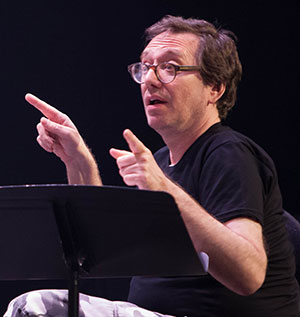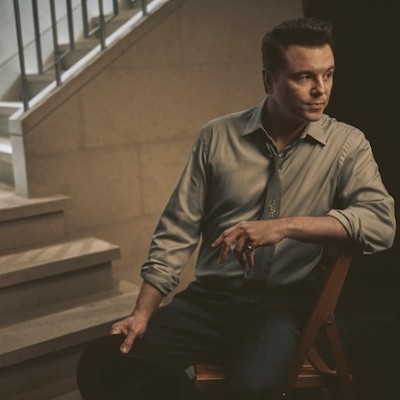Dec 9, 2025 12:28 PM
In Memoriam: Gordon Goodwin, 1954–2025
Gordon Goodwin, an award-winning saxophonist, pianist, bandleader, composer and arranger, died Dec. 8 in Los Angeles.…

John Zorn
(Photo: )Among its many virtues, including its status as one of the most important and longstanding avant garde festivals in all of the Americas, the Festival International de Musique Actuelle de Victoriaville (FIMAV) in Victoriaville, Quebec, has become known as a likely spot for Zorn sightings. Polymath musician/composer/record company micro-mogul John Zorn, an admitted and avowed fan of the festival which founder/director Michel Levasseur has built over the past 29 years, has brought many projects to this small, lovely town over many years.
Surprisingly, this year’s model of FIMAV, which took place on May 17–20, was the first in which Zorn actually offered up what could be called a world premiere, a conceptual piece called “The Concealed.” Inspired by ancient Jewish texts and imagery, in this body of music, Zorn traced along pathways between a jazz rhythm section with his Masada strings work, between Jewish melodic colors and mash-ups of juiced swing and ambling free play.
There was greater musical interest the night before, when Zorn led his post-modern MJQ spinoff, “Nova Express,” with pianist John Medeski, drummer Joey Baron, bassist Trevor Dunn and Kenny Wolleson in his impressive, distinctive role as vibraphonist. Here, abstract splashes, linear mazes with links to classical serialist tradition more than jazz, per se, and Zorn’s Latin-esque lounge music side come together and butt heads, artfully. Coincidentally, this piece relies on Zorn’s role as a conductor, guiding the players’ actions and intensities from his seated perch, and the previous concert featured the “conduction” services of the great madcap vocalist Phil Minton, who led a large, game group of community volunteers in one of Minton’s primal, funny and phenomenological “Feral Choir.”
One of the intriguing sideline features of the 2012 festival was an expansion of last year’s focus on sound art, with a series of publicly accessible sound art works in government buildings and in the great outdoors. That new feature makes for an artistically sympathetic and resourceful means of reaching out to the Victoriaville community, which otherwise may or not be interested in the innately esoteric musical realm which FIMAV traffics in and is, in its way, world-famous for.
Unfortunately, a planned visit by a power trio led by bassist Bill Laswell, with Finnish guitar shredder Raoul Björkenheim and Swedish drum force Morgan Ågren transformed into a bassless duo due to Laswell’s unexplained no-show. But the duo made some muscular, thunderous and ultimately joyful noise in the situation, and the other consolation prize was a late-breaking booking of the great bassist Henry Grimes, putting in a short but energizing set on bass and violin, graced with his special charisma. Further adventures in power trio urgings went down the night before, when sinuous guitarist Joe Morris, captivating drummer Mike Pride and always-tuned-in keyboardist Jamie Saft summon up dynamically-controlled raucousness and sound-action painting.
Genres wax and wane in this festival’s definitively flexible agenda, but there was a distinctly more jazz-flavored feeling in town this long weekend. From that world came the fascinating structure-meets-abandon artistry of guitarist Mary Halvorson’s quintet—a clear festival highlight—and a momentous arrival of Wadada Leo Smith’s ambitious, socio-historically themed new epic, “Ten Freedom Summers,” here in its compact form. Further social commentary-driven conceptualism came through a chapter in saxophonist Matana Roberts’ “Coin Coin” series, dealing with African American experience in expansive, vivid musical form.
Roberts, who has strong musical connections in Montreal, built her large ensemble from Quebecois players, and Montrealers split the difference between improvisation and compositional scheming in the adventuresome Ensemble SuperMusique. Elsewhere among the Canada contingent of the program, Canadian-in-Berlin, bassist Miles Perkin led an impressive, introspective quartet, evoking something akin to ECM aesthetics.
For this FIMAV edition, the best arrived last, as the all-star improvising unit known simply and grandly as The Trio stole the show in the closing night slot. AACM-connected allies Roscoe Mitchell (reeds) George Lewis (trombone and deftly-controlled computer) and veteran AACM pianist Muhal Richard Abrams make some profound yet ever-flexible and malleable music together, with uncommon empathy. One of the more exciting groups on the current post-free jazz scene, The Trio once again demonstrated the bracing beauty and strength of collective, ear-powered playing, with roots going back fifty years and still alive in the moment. They may have trouble doing business in art-phobic America - south of the Canadian border, that is—but their performances at the Guelph, Ontario, jazz festival two years ago and now in Victoriaville were ripe causes for what should be, in an ideal cultural environment, all-American pride.
—Josef Woodard

Goodwin was one of the most acclaimed, successful and influential jazz musicians of his generation.
Dec 9, 2025 12:28 PM
Gordon Goodwin, an award-winning saxophonist, pianist, bandleader, composer and arranger, died Dec. 8 in Los Angeles.…

Flea has returned to his first instrument — the trumpet — and assembled a dream band of jazz musicians to record a new album.
Dec 2, 2025 2:01 AM
After a nearly five-decade career as one of his generation’s defining rock bassists, Flea has returned to his first…

“It’s a pleasure and an honor to interpret the music of Oscar Peterson in his native city,” said Jim Doxas in regard to celebrating the Canadian legend. “He traveled the world, but never forgot Montreal.”
Nov 18, 2025 12:16 PM
In the pantheon of jazz luminaries, few shine as brightly, or swing as hard, as Oscar Peterson. A century ago, a…

Dec 11, 2025 11:00 AM
DownBeat presents a complete list of the 4-, 4½- and 5-star albums from 2025 in one convenient package. It’s a great…

Seth MacFarlane takes a turn from his television and film career to sing arrangements made for Frank Sinatra, but never recorded.
Nov 18, 2025 12:04 PM
“I’m not gonna lie to you — I don’t know why I thought this was about The Naked Gun, but I’m happy it’s…